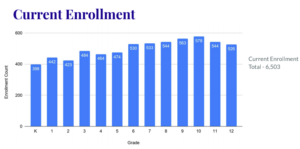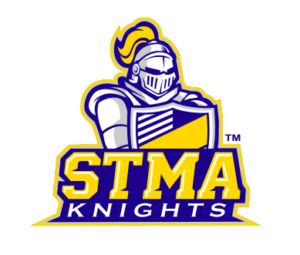Minnesota school districts must report a variety of student enrollment data to the state’s Department of Education every October 1, and Kris Crocker, Director of Business Services for the St. Michael-Albertville school district, said these numbers impact next year’s revenue calculations for compensatory and Q-Comp program funding.
The STMA district grew by 97 students over last year for a total of 6,503 students, and Superintendent Dr. Ann-Marie Foucault said open enrollment drove that growth with approximately 200 additional open enrollees over last year and flat growth among in-district residents.
“When you look at the numbers, it’s the open enrollees increasing our enrollment, not the in-district ones,” Foucault said. “The open enrollees are helping us grow and maintain the numbers we need for our budget.”
This year’s kindergarten class came in as the district’s smallest, with 398 kindergarteners enrolled. The largest class is grade 10, with 578 students. Grades 6-12 all have over 500 students, and grades 1-5 have student populations in the 400s.

courtesy of the STMA school district
Here are the highlights of what Crocker presented to the school board Monday evening on the state of STMA enrollment and class sizes.
Open Enrollment
The number of STMA open enrollees has steadily risen since 2011, and Crocker said these students generated an additional $15 million for the district between 2011 and the end of last fiscal year.
She said all buildings have room to grow for now, with the middle school buildings closest to capacity but also with smaller class sizes on the horizon for those grades.
Foucault said St. Michael residential construction is concentrated within the STME and Middle School East boundaries, and she said they planned for this in the 2017 bond by adding classrooms to Albertville Primary, allowing the early childhood program to move from STME to its original home at the primary school in preparation for STME’s growth. That growth, however, has been slower than expected, possibly due to the higher cost of these new homes compared with new construction projects in Otsego, where STMA sees much of its open enrollment.
Board member Carol Steffens asked what will happen to open enrollees if development in St. Michael picks up to a faster pace. Foucault said open enrollment is working fine for now, but she said school attendance boundaries for open enrollees may have to shift in the future if the numbers require it. The school board could also vote to limit open enrollment in the future if space becomes tight.
“If we continue this trend it’s going to cause issues if the projected development in-district comes to fruition,” board member Hollee Saville said.
Board member Tim Lewis pointed out that the district has the school capacity to easily manage the four largest grades currently coming through the middle and high school buildings, which he called a comforting sign.
Fewer Free and Reduced Lunch Students
Minnesota school districts must also track specific populations of students for the MDE, and STMA saw some changes to its special populations over the last year. For one, the percentage of students on free or reduced lunch prices took a significant dive to 9.3 percent, its lowest number since before 2007. The free and reduced student population has hovered around 12 percent or above since 2009.
Crocker attributed this change to a strong economy plus a decrease in the number of students in the district who qualify for direct free/reduced lunch certification, such as homeless youth or those in foster care. The majority of program participants are not directly certified and must re-apply and qualify each year through the USDA.
The special education student population, conversely, continues to rise. 10.42 percent of the district’s students now qualify for some type of special education services, up nearly 2 percentage points from 2016. The percentage of white students in the district has edged down 1 percent over last year, with slight gains for all other races. The population of students learning English as a second language remained constant from last year.
Class Sizes
Crocker said all elementary grade levels are at or below class size targets besides grade 3. The district aims for 24 students per third grade classroom, but both Big Woods and STME third grade classes have more than that, upping the district average to 25.6 per class. This year STMA averages 19 students per kindergarten classroom, 21 for grades 1 and 2, and 25.8 for grade 4. Crocker said middle and high school core classes average between 27-30.
Foucault said STME, which has the largest third grade classes, saw several late-summer student registrations, and she said the administrative team decided to hold off on hiring an additional teacher since the district already plans to deficit spend nearly $700,000 this fiscal year. Foucault said STME averages 27.2 third graders per classroom, which she said is below neighboring districts and below their “red flag” number of 30 students per classroom.
“I would agree with that,” board chair Drew Scherber said of their decision. “We’d all like them even below the target if we had unlimited funds, but we don’t have unlimited funds.”
